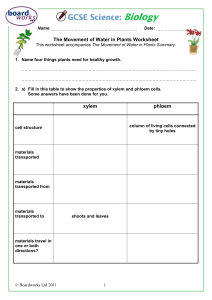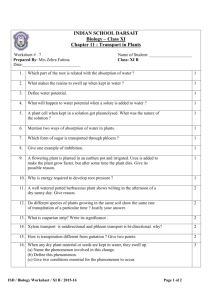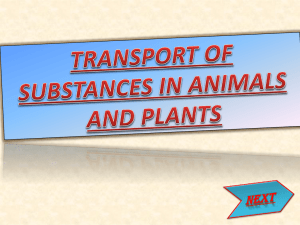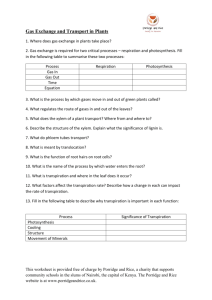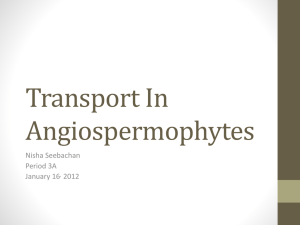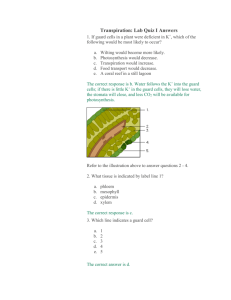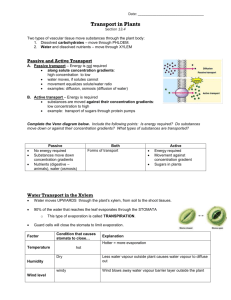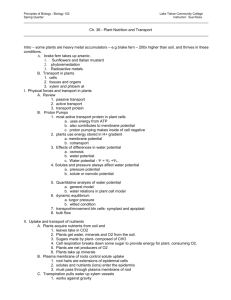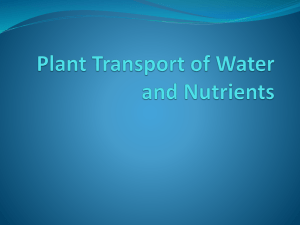Water Movement in Plants Worksheet - Biology
advertisement
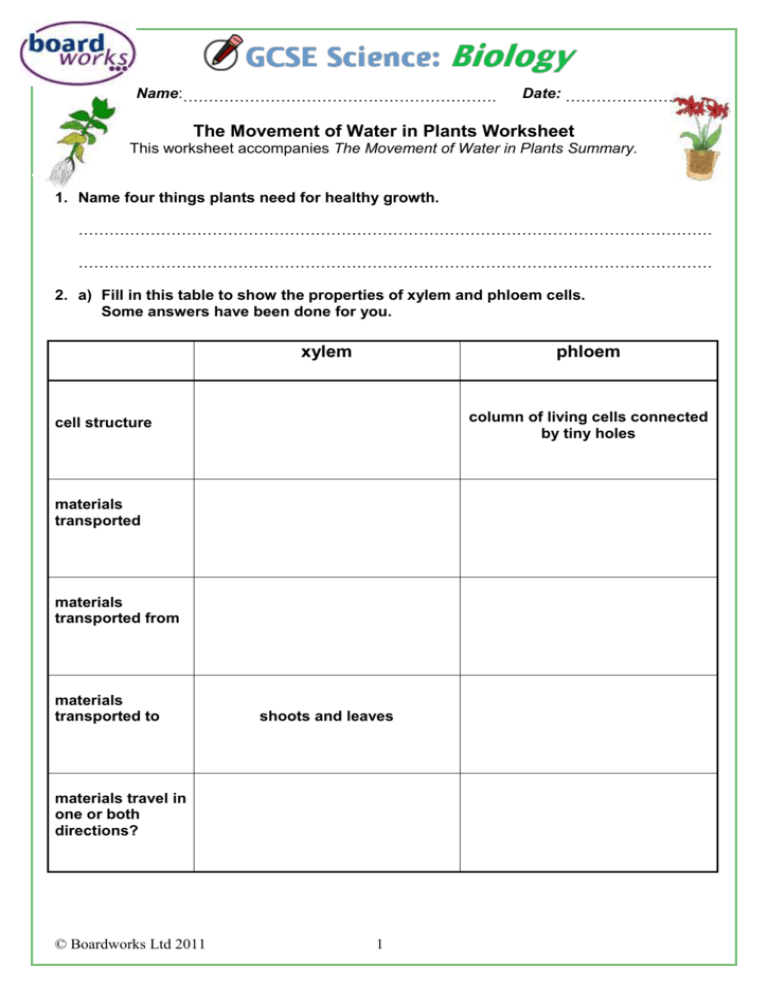
Name:……………………………………………………. Date: …………………… The Movement of Water in Plants Worksheet This worksheet accompanies The Movement of Water in Plants Summary. 1. Name four things plants need for healthy growth. …………………………………………………………………………………………………………… …………………………………………………………………………………………………………… 2. a) Fill in this table to show the properties of xylem and phloem cells. Some answers have been done for you. xylem phloem column of living cells connected by tiny holes cell structure materials transported materials transported from materials transported to shoots and leaves materials travel in one or both directions? © Boardworks Ltd 2011 1 Name:……………………………………………………. Date: …………………… 2. b) Xylem and phloem are arranged in plants as vascular bundles. They form a continuous system connecting roots, stems and leaves. Describe the arrangement of xylem and phloem in a plant’s root, stem and leaves. i) Root: …………………………………………………………………………….……………….. ………………………………………………………………………………………….……………. ii) Stem:………………………………………………………………………………… …………………………………………………………………………….………………. iii) Leaves:…………………………………………………………………………….……………... ………………………………………………………………………………………………………… 3. Describe two ways the structure of a leaf is adapted to prevent excessive water loss from the plant. …………………………………………………….……………….... …………………………………………………………………...…... ………………………………………………………………..…..….. ……………………………………………………………………..… …………………………………………………………………………………. ………………………………………………………………………………...………………………… . 4. What are stomata and what is their function in a plant leaf? …………………………………………………………………………………….…………… …..…………………………………………………………………………………...…… ……………………………………………………………………………………………… ……………………………………………………………………………………………………….. …………………………………………………………………………………………………………… © Boardworks Ltd 2011 2 Name:……………………………………………………. Date: …………………… 5. Turgor pressure affects plant cells. Complete the sentences for each of the cells shown below: When turgor pressure is ………..…………, the water content of the cell increases, pushing on the cell walls. The cell is said to be ……….…………. When turgor pressure is ………….……, the pressure on the cell walls is low. The cell is said to be …………..………. When turgor pressure is very …………..………, the …………..……… pulls away from the cell wall, damaging the cell. The cell wall is said to be …………..………. 6. How does low turgor pressure affect a plant? …………………………………………………………………………………………………………… …………………………………………………………………………………………………………… 7. Animal and plant cells manage water uptake and loss in different ways. As animal cells do not have cell walls, there is nothing to prevent them from taking in to much water. When this happens the cell bursts. What is the correct term for this? ………………………………………………………………………………………………………. 8. Explain two ways in which root hair cells are adapted to increase water up-take by osmosis. ……………………………………………………………….….……. ………………………………………………………………..…………. ………………………………………….......................................................................................... ................................................................................................................................................... © Boardworks Ltd 2011 3 Name:……………………………………………………. Date: …………………… 9. Redwoods are the tallest species of tree in the world. Explain how the process of transpiration causes water to travel from the roots to the branches of a tree this size. …………………………………………………………………………………………………………… …………………………………………………………………………………………………………… …………………………………………………………………………………………………………… …………………………………………………………………………………………………………… 10. Fill in the gaps in the following sentences using the words in the box. a) Plants lose water when they open the stomata in their leaves to let in …………………. b) Water always moves from an area of ……………….. concentration to an area of ………………… concentration. c) This movement of water is called …………………. d) ………………. the light intensity will increase the rate of transpiration. e) Decreasing the ……………….. will increase the rate of transpiration. f) ………………… the air movement and temperature will decrease the rate of transpiration. high osmosis humidity low decreasing increasing carbon dioxide 11. Describe how you could use the equipment shown to investigate the effect of temperature on transpiration. Think about which variables you will change and which you will ensure stay the same. ……………………………………………………………………...... ……..………………………….………………………………….….. …………………………………………………………...……...…… ……………………………………………………………………….. ………………………………….………………………………………………………………..……… …………………………………………………………………………………………………………… …………………………………………………………………………………………………………… ………………………………..….……………………………………………………………………… ………………………………..….……………………………………………………………………… © Boardworks Ltd 2011 4
